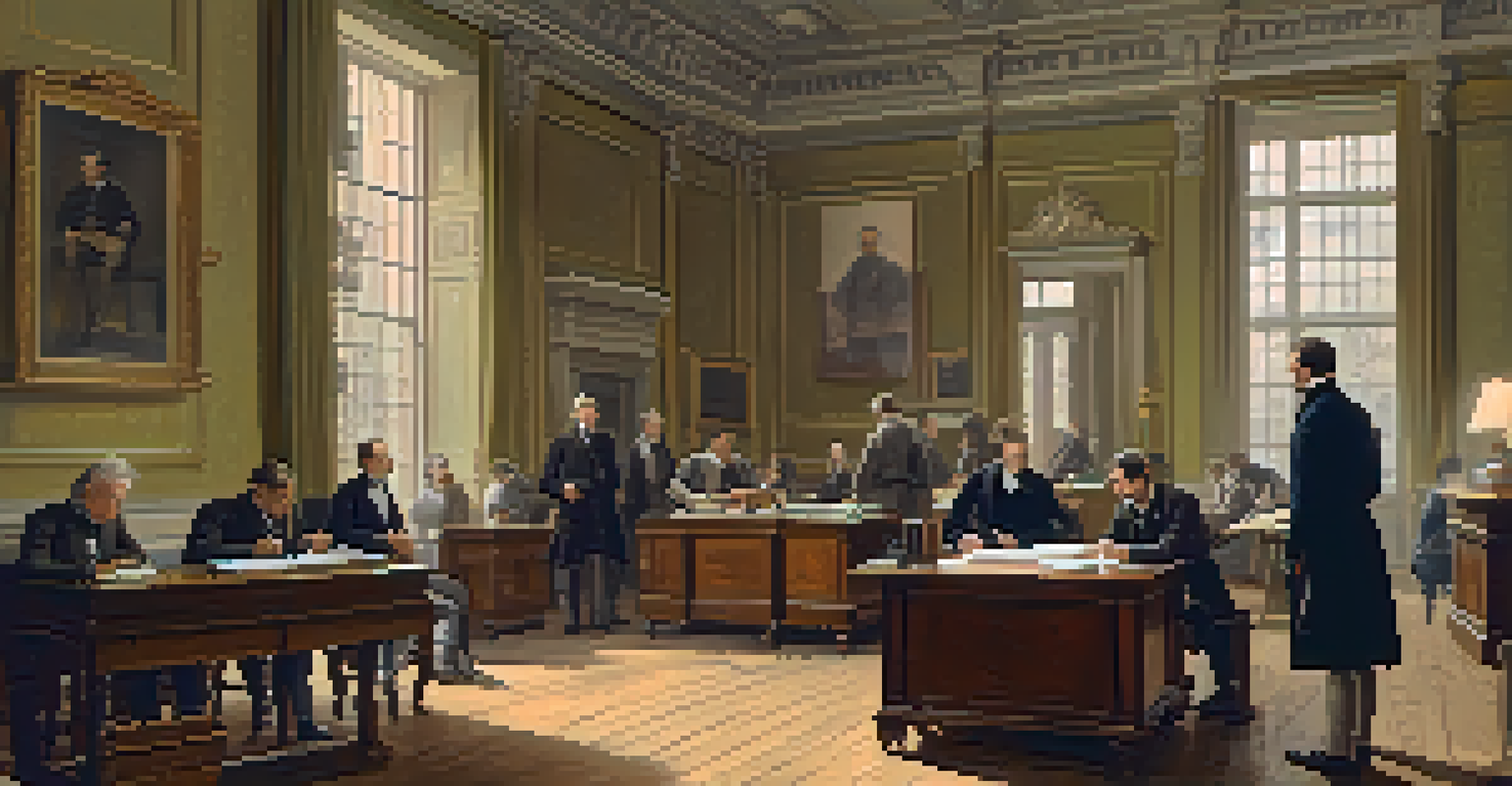The History of Tax Brackets and Their Evolution

The Origins of Taxation: A Brief Overview
Taxation has been a part of human society for thousands of years, with roots tracing back to ancient civilizations. Early forms of taxes were often in the form of goods or labor, where citizens contributed resources to support the ruling class and public services. For example, the Egyptians used a system of grain tax to fund monumental projects like the pyramids.
The hardest thing in the world to understand is the income tax.
As societies evolved, so did the methods of taxation. The Romans implemented a more structured approach, introducing a property tax and taxes on goods traded within their empire. This shift marked a significant move towards what we now understand as a more organized tax system, setting the stage for future developments.
By the time we reached the Middle Ages, taxation had become more sophisticated, with various forms of taxes emerging across Europe. Whether it was the 'tithe' in England, a 10% tax on produce, or the 'poll tax' implemented by some rulers, the concept of taxing citizens based on their wealth and resources began to take shape.
The Birth of Progressive Taxation in the 19th Century
The 19th century marked a pivotal moment in taxation with the introduction of progressive tax systems. This approach aimed to tax individuals based on their ability to pay, meaning wealthier citizens would contribute a larger percentage of their income. This was a response to growing economic inequality during the Industrial Revolution, where the rich were becoming richer, while the working class faced significant hardships.

One notable example was the introduction of income tax in Britain in 1799, designed to fund the war against Napoleon. Initially, it was a temporary measure, but its success led to its reintroduction and gradual evolution into a more permanent fixture. This laid the groundwork for similar systems worldwide, including in the United States.
Taxation's Ancient Roots
Taxation has evolved from ancient goods and labor contributions in civilizations like Egypt to structured systems in Rome, shaping today's tax frameworks.
By the end of the century, many countries had adopted progressive taxation, recognizing the need for a fairer distribution of wealth. This movement helped to establish a social safety net, allowing governments to fund public services like education and healthcare, which were essential for societal progress.
The Establishment of Federal Income Tax in the U.S.
In the United States, the federal income tax was first introduced during the Civil War in 1861 as a temporary measure to cover war expenses. However, it wasn't until the 16th Amendment was ratified in 1913 that income tax became a permanent fixture in American law. This amendment granted Congress the authority to levy taxes on personal income, significantly altering the financial landscape.
In this world, nothing can be said to be certain, except death and taxes.
Initially, the tax rates were relatively low, with only a small percentage of the population required to pay. The structure consisted of just a few brackets, ensuring that the burden was not felt heavily by the average citizen. As the country entered the Great Depression, however, the need for increased revenue led to a re-evaluation of tax brackets and rates.
The increasing complexity of economic challenges during the 20th century prompted more adjustments to the tax system. Throughout the decades, rates fluctuated, reflecting the changing political climate and the need for revenue to support government programs, especially during times of crisis.
Tax Brackets and World War II: A Significant Shift
World War II brought about a drastic change in the U.S. tax system, with the introduction of withholding taxes to ensure the government had a steady flow of revenue. This system made it easier for the government to collect taxes directly from wages, a practice that continues today. The urgency of war funding led to an expansion of tax brackets, increasing the number of taxpayers significantly.
During this period, tax rates climbed to unprecedented levels, with the highest bracket reaching over 90% for the wealthiest Americans. This was a stark shift from previous years and reflected the government's need to finance the war effort. It also sparked debates about fairness and the role of the government in wealth redistribution.
Progressive Taxation Emergence
The 19th century introduced progressive taxation, targeting wealthier citizens to address growing economic inequality during the Industrial Revolution.
As the war ended and the economy stabilized, many of these tax measures were rolled back, but the concept of tax brackets remained. The experience of World War II solidified the idea that tax policy could be a tool for economic management, influencing future tax reforms in the following decades.
The Tax Reforms of the 1980s: Simplification and Change
The 1980s were a decade of significant tax reform in the United States, characterized by the Economic Recovery Tax Act of 1981. This legislation aimed to simplify the tax code, reducing the number of tax brackets from 14 to just 2, which fell into a range of 11% to 28%. The idea was to encourage investment and economic growth by lowering tax burdens on individuals and businesses.
However, these changes sparked controversy, as critics argued that the benefits primarily favored the wealthy. The dramatic reduction in rates for higher earners led to increased income inequality, raising questions about the fairness of the tax system. This period illustrated the ongoing struggle between economic policy and social equity.
The Tax Reform Act of 1986 further revised the tax code, closing loopholes and broadening the tax base. While it maintained lower rates, it also increased the number of taxpayers who were subject to federal income tax, showing that tax brackets remained a dynamic and evolving aspect of economic policy.
Modern Tax Brackets: Current Structure and Trends
Today, the U.S. tax bracket system consists of seven income tax brackets, ranging from 10% to 37%. These brackets are designed to ensure that individuals are taxed according to their income level, with higher earners paying a larger percentage. The current structure reflects ongoing debates about wealth distribution and the role of taxes in society.
In recent years, discussions around tax reform have intensified, particularly regarding the fairness of the tax system. Proponents of progressive taxation argue for higher rates on the wealthiest individuals to address income inequality, while others advocate for further simplification of the tax code. This tug-of-war highlights the complexities and challenges of achieving a balanced tax system.
Modern Tax Brackets Explained
Today's U.S. tax system features seven income tax brackets that reflect ongoing debates about fairness and the role of taxes in addressing income inequality.
Moreover, economic events such as recessions or pandemics can lead to rapid changes in tax policy. For instance, the COVID-19 pandemic prompted discussions about new tax measures to support struggling businesses and individuals, showing that tax brackets are not static but rather a reflection of the current socio-economic landscape.
The Future of Tax Brackets: What Lies Ahead?
As we look to the future, the evolution of tax brackets will likely continue to adapt to changing economic conditions and societal values. With increasing conversations around climate change, healthcare, and wealth inequality, tax policy may play an essential role in addressing these pressing issues. Policymakers are exploring innovative tax structures that could better align with contemporary challenges.
Additionally, the rise of digital economies and remote work has introduced complexities in taxation that could lead to new frameworks. As more individuals and businesses operate across borders, the traditional tax bracket model may need to evolve to accommodate these shifts in the workforce and the economy.

Ultimately, the future of tax brackets will depend on collective societal choices about equity, fairness, and the role of government. As discussions continue, it’s clear that tax policy will remain a vital tool for addressing both current and future challenges, shaping the economic landscape for generations to come.